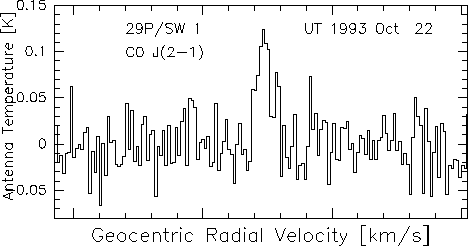
| Schwassmann-Wachmann 1 |
|---|
Cometary CO was discovered in P/Schwassmann Wachmann 1 from observations of the [2-1] rotational transition at 230 GHz using the 15 meter diameter JCMT on Mauna Kea. The spectrum below shows that the line is faint and narrow: the typical FWHM is much less than 1 km/s. The line also appears blue- shifted relative to the instantaneous geocentric radial velocity of the comet. We believe this is an artifact of day-side ejection from the nucleus (unlike near-Sun comets, SW1 is always viewed at small phase angle, so gas released from the hot day-side is naturally blue-shifted). Similar blue-shifted emission is also seen in JCMT data on C/Hale-Bopp, which is likewise far from the sun and viewed at small phase angle. The magnitude of the blue-shift is something of a puzzle. The adiabatic expansion of CO should produce maximum velocity ~200 m/s at 7AU, whereas we measure 450 m/s. The excess velocity may imply a near-nucleus heat source for the gas, possibly heat transfer by percolation through a hot mantle, or (more likely) collisional heating by coma dust.The area of the CO line in SW1 implies outgassing at rates from 1000 kg/s to 2000 kg/s. These high rates are sufficient to drive the coma activity observed in SW1 at large distances. Repeated observations from the JCMT have shown that the CO outgassing is temporally variable, but never absent.
Reference: Senay and Jewitt (1994), Nature, 371, 229-231.

| Submillimeter | Jewitt |
|---|
Last Updated February 1997